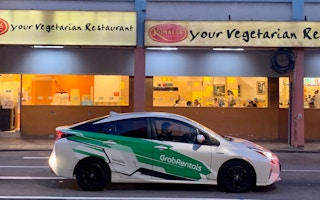Grab, Southeast Asia’s most widely used ride-hailing app, is launching a new feature that enables its customers to offset the carbon emissions of their journeys.
To continue reading, subscribe to Eco‑Business.
There's something for everyone. We offer a range of subscription plans.
- Access our stories and receive our Insights Weekly newsletter with the free EB Member plan.
- Unlock unlimited access to our content and archive with EB Circle.
- Publish your content with EB Premium.
An optional US$0.10 in addition to the fare will go towards reforestation and conservation projects in Southeast Asia that will absorb an equivalent amount of carbon dioxide as that produced by a ride in a Grab vehicle.
The offset function will be available in its biggest market, Indonesia, as well as Malaysia and Thailand from July before rolling out in Grab’s other Southeast Asian markets, Singapore, Vietnam, the Philippines, Cambodia and Myanmar in the third quarter of the year.
Funds raised from the offsets will go towards tree-planting initiatives in Indonesia, Malaysia, Thailand and Vietnam through partner non-government organisations.
Grab’s offset function will enable users to virtually travel to their trees, name them, view them, and learn about the farmers who planted them.
Grab’s offsetter launches off the back of a study of its customers which found that 82 per cent were worried about climate change, and are trying to reduce their carbon footprint. Of those who are concerned but not doing anything about it, 44 per cent said they did not know how, and 31 per cent felt it was too difficult to take action.
The service launches four months after news emerged that Grab was hatching a plan to decarbonise its operations, and just as rival ride-hailer Gojek was working on a similar decarbonisation plan. Gojek launched an in-app carbon offset function last September.
Grab has so far not declared an ambition to achieve net-zero emissions in its latest environmental, social and governance report, published on Tuesday. Last month, Gojek announced that it would be net-zero by 2030.
Grab told Eco-Business that it planned to announce a science-based net-zero carbon target in 2022, along with a roadmap to achieve carbon goals.
The company said its approach to decarbonisation would involve accelerating the transition from petrol and diesel vehicles to hybrid and electric vehicles (EVs), and using artificial intelligence algorithms to make deliveries and rides more efficient, through ride batching and sharing.
The company also plans to use offsets to reduce net emissions, including investing in nature-based solutions that boost carbon sequestration, and provide livelihoods for forestry communities in Southeast Asia.
Cheryl Goh, Grab’s group head of marketing and sustainability, said that the company had taken a number of steps to reduce its environmental footprint in recent years, including investing in its EV rental fleet, but said “there is still a lot of work to be done to get us to a net-zero carbon future.”
In a statement, the company pointed to numerous barriers to adoption for EVs in Southeast Asia. A survey of the firm’s drivers in Singapore found that high vehicle costs, a lack of charging locations and long wait times for charging are the key hindrances.
Grab also announced on Tuesday that, in partnership with Hyundai Motor Group, it would be launching pilot programmes in Singapore, Indonesia and Vietnam to test new models for EVs, such as battery-as- a-service and car-as-a-service leasing arrangements, and EV financing options for Grab’s driver and delivery partners.
The company told Eco-Business that a feature that enables customers to choose an EV rather than a petrol or diesel-powered ride is “in the works”.










